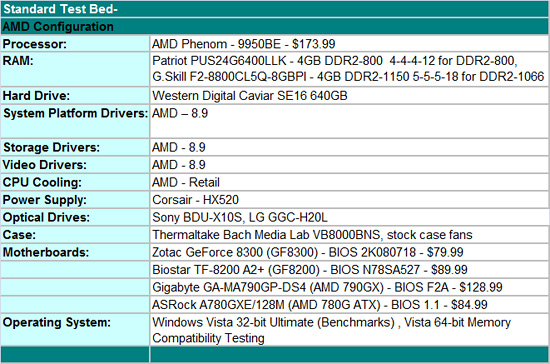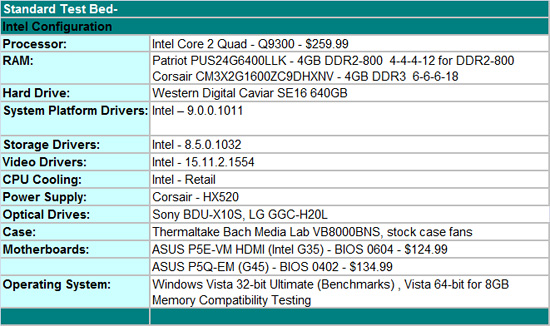The IGP Chronicles Part 2: AMD 780G vs. Intel G45 vs. NVIDIA GeForce 8200
by Gary Key on October 14, 2008 12:40 PM EST- Posted in
- Motherboards
AMD vs. Intel vs. NVIDIA: Fight
At the heart of AMD's 780G we have what AMD is calling a Radeon HD 3200 graphics core, providing the most powerful (on paper) integrated graphics on the market today. The table below should shed some light on the balance of power:
| AMD 790GX | AMD 780G | Intel G45 | Intel G35 | NVIDIA GeForce 8300 | NVIDIA GeForce 8200 | |
| Graphics | Radeon HD 3300 | Radeon HD 3200 | GMA X4500 |
GMA X3500 |
GeForce 8300 mGPU | GeForce 8200 mGPU |
| Core Clock | 700MHz | 500MHz | 800MHz | 667MHz | 500MHz Core / 1.5GHz Shader |
500MHz Core / 1.2GHz Shader |
| Shader Processors | 8 (5-way) | 8 (5-way) | 10 |
8 |
8 | 8 |
| Full H.264/VC-1/MPEG-2 HW Decode | Yes | Yes | Yes | No | Yes | Yes |
While Intel's G35, NVIDIA's GeForce 8200, and AMD's 780G all have 8 of what we're calling "SPs" or stream processors, their clock speeds and capabilities vary greatly from one to the next. Intel and NVIDIA are closest in this regard, as each SP has a peak throughput of a single instruction per clock. AMD's architecture is a bit more capable in the sense that each SP can have a maximum throughput of 5 instructions per clock. It gets a bit more complicated as NVIDIA has separate hardware for transcendental operations, which occupy one of the five "slots" in each AMD SP.
If you multiply it all out that gives Intel a throughput of 8 instructions per clock for G35, 10 for G45, 10 for NVIDIA's GeForce 8200 (where two are transcendental operations) and 40 for AMD. In terms of worst case throughput however, AMD falls down to 8 per clock (assuming the compiler can't feed the hardware 4 shader ops + 1 transcendental per SP) as does NVIDIA. This worst case rarely happens, but it is definitely worth noting.
Taking clock speeds into account, Intel really falls behind here. While G45 has a similar instruction throughput to NVIDIA's architecture, it runs its SPs at 800MHz while NVIDIA runs its at 1.4GHz giving NVIDIA a 75% raw performance advantage. AMD's core runs much slower at 500MHz, but the SPs are far more complex, so we end up with the following scenarios:
In the best case for AMD, the 780G is 43% more powerful than the GeForce 8200, but in the worst case NVIDIA's hardware is 1.8x faster than AMD's thanks to the clock speed advantage and AMD's dependency on ILP within an instruction stream. The integrated graphics race then becomes even more variable than how AMD/NVIDIA stack up with discrete GPUs; the swing from an AMD advantage to an NVIDIA advantage is much wilder than what we see with the GeForce GTX 260 vs. Radeon HD 4850.
The Test
Our Intel test bed today features the Q9300 quad-core processor and the AMD/NVIDIA platform features the Phenom X4 9950BE. Both of theses processor offers terrific performance with decent power consumption and thermals for the cost. Our Patriot DDR2-800 Viper 4GB memory kit has served us well for the past few months and we highly recommend it. We chose Corsair for our HX-520W power supply that has served us well in testing a variety of IGP solutions. Our favorite midrange HDD continues to be the Western Digital SE16 640GB that provides the near perfect balance of price, performance, and capacity.
Our motherboard selection represents a small cross section of IGP products based on the Intel G35/45, AMD 780G, and NVIDIA GeForce 8200/8300 products. While we tested over fourteen motherboards for this article, we're using the results from the best of the best for each chipset.












41 Comments
View All Comments
duploxxx - Tuesday, October 14, 2008 - link
nice review, gives a clear ups and downs from each part. there's off course always a reason to recommend an intel part in your conclusion even if you brake it to the ground in the earlier pages....this time you took power consumption, which was one part you would already know from the moment you made your base specs. however for a basic htpc people don't buy quadcores, they buy dual's.put a 4850e on the plate against e5200 and start all over again, i'am sure you will get a whole other conclusion and 0 reasons to ever buy a s775 platform for htpc in stead you would pick the nvdia/amd offerings with am2 chipset.
npp - Tuesday, October 14, 2008 - link
I suspect the E5200 system would be faster at the end - running at equal clock speeds Core 2 CPUs tend to faster than the old Athlons (at least I think so). I'm not sure what goes for the power consumption, but I really don't understand why one should care about that, anyway. Decent coolers are all around and saving the planet by cutting off some 20-30-50W from your bill is simply ridiculous. As long as we're talking of numbers around the 100W mark, anything goes.strikeback03 - Tuesday, October 14, 2008 - link
Anandtech has seemed to favor quad-cores for transcoding duties in past HTPC articles.harshaflibbertigibbet - Tuesday, October 14, 2008 - link
I hope you will also be reviewing the much delayed and finally launched NVIDIA GeForce 9300/9400 chipsets for the Intel platform. In my opinion, they would end up being the best solution for HTPC users.Badkarma - Tuesday, October 14, 2008 - link
Hi Gary,I read through your article which is very good btw. However, I couldn't find what driver versions you were using to test with. Sorry if I just missed it.
Golgatha - Tuesday, October 14, 2008 - link
I have a HTPC running an Intel E8400 C2D, Zalman 9500 HSF, 6GB RAM, a passively cooled ATI 2600 Pro 256MB, Lite-On SATA Blu-ray/HD DVD combo optical drive, Abit IP35-E, 3 hard drives (250GB and 2x750GB), 380w Earthwatts PS, 4 fans (this includes the PS and CPU fan), and a HT Omega Striker 7.1 discreet sound card. The system runs Vista 64bit Home Premium.My requirements for a HTPC were for it to be out of sight (tucking it behind the entertainment center and using a Bluetooth Logitech DiNovo Mini works great for me), run cool and quiet, and not use much electricity. Running 2xFolding@Home clients, a Tversity server for my PS3, and playing a Blu-ray movie uses about 115w system power for the entire system (measured with a kill-a-watt brand device).
I think the configurations tested weren't really representative of how folks build their HTPC, unless you're assuming it's a do-it-all type of PC, which isn't really a HTPC at that point IMO?
Why in the world would a dedicated HTPC need a quad core CPU or a 520w PSU? Dual core 45nm parts are more than capable of even the most demanding tasks. Also, a 520w PSU for a 100-150w system is completely inefficient.
http://www.anandtech.com/casecoolingpsus/showdoc.a...">http://www.anandtech.com/casecoolingpsus/showdoc.a...
Also, barebones motherboards are cheaper than their IGP counterparts by at least $15-$20 (my Abit board was $70 after MIR), which gives a bit of leeway to purchase a $30-$50 dedicated video card that will give a much better end user experience at the end of the day. Also, when something better comes out (hey, I'm interested in AMD's new 4550 etc. series too), you don't have the unnecessary components on the motherboard sucking electricity.
fic2 - Tuesday, October 14, 2008 - link
That is exactly what I don't understand about the recent "HTPC" articles on here. For some reason they think that people actually use quad monster processors for HTPCs. I got a $25 BE-2400 45W cpu that I intend to use in an HTPC, not some 125W beasty thing that triples my power usage.androo - Wednesday, October 15, 2008 - link
I totally agree! HTPCs are for the living room and should make little to no noise. 140W CPUs have no place in such a rig. Save that for a gaming rig that goes in the bedroom or den (especially if your wife is a light sleeper!).tonyintoronto - Wednesday, October 15, 2008 - link
I don't get it either. HTPC in my opinion are to be low power systems, dedicated to movies, music and TV... Doesn't make any sense to me to see 3x and quad cores tested. I use a AMD 4450E and i'm already way "oversized", that processor can play all formats of HD running at 1.1GHZ w/out any issues together with a cheap asus 3450 card. That and the gaming performance, who in they right mind would game with integraded graphics? its like showing to 1/4 mile race with a horse and carriage.I do agree with them, the 780G and G45 are poor excuses for HTPC boards, IMHO the cheapest possible board with ati 4650 or 4670 makes the most sense. Don't get me started on those 550W power supplies :)
Mathos - Wednesday, October 15, 2008 - link
No idea why they used quad core, other than the fact that a quad would spend more time in low power mode and have lower CPU usage than a dual. That and there are no AMD dual cores out yet that use HT 3.0, although the x2 6500 should be. Most of the AMD based boards are adversely effected by using an older X2 instead of something that uses HT3.0.Anyone not seeing the point of a 780g/790gx board, or an nForce 8200/8300 board for an HTPC is not thinking. The point is to not need a discrete card. Many HTPC's use low profile cases, which make finding an adequate video card difficult. Not to mention with the 780g/790gx you can later install a $50 discrete 3650 or 3450 and run it in Xfire with the IGP for better gaming performance. Same goes for the lower end 8000 and 9000 cards on the nforce chipset.
As far as the PSU goes it leaves room for possibly adding in a discrete card later. Also remember that most PSU's are most effecient at around 50% load which happens on some of the AMD systems under heavy load. Not to mention if you want to have a silent PSU you need to keep the load low so the fan isn't humming constantly, which would happen on a lower rated PSU.